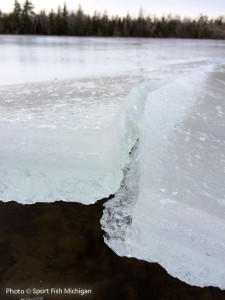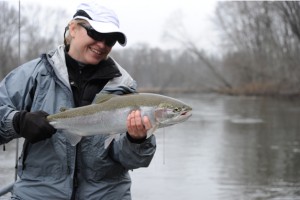
Ice has covered many of the northern Michigan inland lakes, and the itch to get out onto the ice for some ice fishing is growing stronger each day. The thrill of fishing through the ice is undeniable, and as we get ready for the upcoming winter ice fishing season, now is a good time to go over a few safety precautions. Early ice can mean some of the season’s best angling opportunities, but it also brings with it a lot of risks. In fact, just 2 days ago, the US Coast Guard had to rescue somebody from the middle of a Traverse City area inland lake.
There are a tremendous amount of factors that can determine not only the thickness of the ice, but more importantly, the strength of the ice. Ice is not all created equally, and this can lead to variations in strength. It is known that the strongest ice is hard, clear ice that has been formed with uninterrupted cold, and calm days and nights. The clearer the ice, minus any snow or bubbles, the stronger the ice is, and thus the higher its capability to hold weight. If the ice is milky or chalky in color, the strength of ice must be considered to be much weaker than if it is clear “black” ice. This is because air bubbles and snow make for very porous ice, which is not solid in nature. While we have had quite a few cold nights so far here in northern Michigan, we have had a lot of wind. This has slowed ice production, and also created weaker ice.
While there is never an acceptable level of ice that can truly be considered safe, there are some factors that can help or hinder ice formation, and definitely some things to consider. It is the breakthrough strength of ice that concerns us most as ice fishermen, so before heading out onto the lake, some of the guidelines and things to keep in mind that we use here at Sport Fish Michigan are the following:
- Do not venture out onto the ice on anything less than 2 inches of clear, hard ice. Very often, with 2 inches or less of ice covering a body of water, there will be soft spots where the ice didn’t freeze uniformly.
- Be aware of things that can lead to soft or thin ice: underwater springs, underwater currents, or even snow will slow the formation of ice. The bigger a body of water, often times, the more current is present. Similarly, moving bodies of water like rivers and streams may be more likely to have unstable ice.
- We want at least 4 inches of hard, clear ice before walking out onto the ice to go ice fishing. 4 inches is the accepted minimum for many authorities, including the Minnesota Department of Natural Resources. This accepted minimum not only has greater strength, it also helps to account for possible weak spots where the ice may not be uniform in thickness.
- Ice thickness in one area of a lake may not be the ice thickness in another area of a lake. For instance, ice in the middle of a lake may have formed later than ice nearer to shore, and in most cases will be thinner.
- Wind has a great affect in ice thickness. In early ice formation, wind will blow frozen skim ice from one side of a lake to another, creating a slightly thicker ice where the wind pushed the ice together.
- Snow is a great insulator, and makes for poor ice formation. Newly formed ice that is mixed with snow can be extremely unreliable. Many authorities and studies have deemed that snow ice is roughly 50% of the strength of clear ice.
- A stationary weight on the ice needs greater strength of ice than the same weight if it is moving. This simply means that while a layer of ice may support a person moving across the ice, it very well may not support that same person if they were stationary in one place.
- Weight distributed over a wider area is better than weight distributed in a smaller area.
- Never venture out onto the ice without informing others of your plans. Always take caution, and have a plan ready should there be a breakthrough.
The Minnesota DNR uses the following table for a very rough guideline for new, clear ice.
(http://www.dnr.state.mn.us/safety/ice/thickness.html)
We can’t wait to begin this season’s guided ice fishing trips here at Sport Fish Michigan, but with the above in mind, we will be content to be patient. Sport Fish Michigan’s ice fishing guides are all fishing fanatics, but despite the itch to get out onto the ice, we will wait a while longer until we venture out. I would much rather wait for safer, thicker ice to satisfy my ice fishing passion than to head out onto iffy ice, risking much more than just getting my boots wet. Fishing’s supposed to be a fun experience, not a harrowing experience. Stay safe, have fun, and we’ll see you out on the ice!












